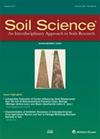Content of soil organic carbon and labile fractions depend on local combinations of mineral-phase characteristics
4区 农林科学
Q2 Agricultural and Biological Sciences
引用次数: 5
Abstract
Abstract. Soil organic matter (SOM) is an indispensable component of terrestrial ecosystems. Soil organic carbon (SOC) dynamics are influenced by a number of well-known abiotic factors such as clay content, soil pH, or pedogenic oxides. These parameters interact with each other and vary in their influence on SOC depending on local conditions. To investigate the latter, the dependence of SOC accumulation on parameters and parameter combinations was statistically assessed that vary on a local scale depending on parent material, soil texture class, and land use. To this end, topsoils were sampled from arable and grassland sites in south-western Germany in four regions with different soil parent material. Principal component analysis (PCA) revealed a distinct clustering of data according to parent material and soil texture that varied largely between the local sampling regions, while land use explained PCA results only to a small extent. The PCA clusters were differentiated into total clusters that contain the entire dataset or major proportions of it and local clusters representing only a smaller part of the dataset. All clusters were analysed for the relationships between SOC concentrations (SOC %) and mineral-phase parameters in order to assess specific parameter combinations explaining SOC and its labile fractions hot water-extractable C (HWEC) and microbial biomass C (MBC). Analyses were focused on soil parameters that are known as possible predictors for the occurrence and stabilization of SOC (e.g. fine silt plus clay and pedogenic oxides). Regarding the total clusters, we found significant relationships, by bivariate models, between SOC, its labile fractions HWEC and MBC, and the applied predictors. However, partly low explained variances indicated the limited suitability of bivariate models. Hence, mixed-effect models were used to identify specific parameter combinations that significantly explain SOC and its labile fractions of the different clusters. Comparing measured and mixed-effect-model-predicted SOC values revealed acceptable to very good regression coefficients (R2=0.41–0.91) and low to acceptable root mean square error (RMSE = 0.20 %–0.42 %). Thereby, the predictors and predictor combinations clearly differed between models obtained for the whole dataset and the different cluster groups. At a local scale, site-specific combinations of parameters explained the variability of organic carbon notably better, while the application of total models to local clusters resulted in less explained variance and a higher RMSE. Independently of that, the explained variance by marginal fixed effects decreased in the order SOC > HWEC > MBC, showing that labile fractions depend less on soil properties but presumably more on processes such as organic carbon input and turnover in soil.土壤有机碳和活性组分的含量取决于局部矿物相特征的组合
摘要土壤有机质是陆地生态系统不可缺少的组成部分。土壤有机碳(SOC)动态受到许多众所周知的非生物因素的影响,如粘土含量、土壤pH值或成土氧化物。这些参数相互作用,对SOC的影响随当地条件的不同而不同。为了研究后者,统计评估了土壤有机碳积累对参数和参数组合的依赖,这些参数和参数组合在局部尺度上因母质、土壤质地和土地利用而变化。为此,从德国西南部四个不同土壤母质的耕地和草地取样表层土壤。主成分分析(PCA)结果显示,不同母质和土壤质地的数据具有明显的聚类特征,不同采样区域间差异较大,而土地利用对PCA结果的解释作用较小。pcacluster被分为包含整个数据集或数据集的大部分的总集群和只代表数据集的一小部分的局部集群。所有聚类分析了有机碳浓度(SOC %)与矿物相参数之间的关系,以评估解释有机碳及其不稳定组分热水可萃取C (HWEC)和微生物生物量C (MBC)的具体参数组合。分析的重点是土壤参数,这些土壤参数被认为是有机碳发生和稳定的可能预测因子(如细粉加粘土和成土氧化物)。对于总聚类,我们通过二元模型发现SOC及其不稳定组分HWEC和MBC与应用预测因子之间存在显著关系。然而,部分低解释方差表明二元模型的适用性有限。因此,混合效应模型被用来确定特定的参数组合,可以显著解释不同集群的有机碳及其不稳定组分。比较测量值和混合效应模型预测的SOC值,可以接受到非常好的回归系数(R2= 0.41-0.91)和低到可接受的均方根误差(RMSE = 0.20% - 0.42%)。因此,在整个数据集和不同聚类组获得的模型之间,预测因子和预测因子组合明显不同。在局地尺度上,特定地点的参数组合能较好地解释有机碳的变异,而总模型对局地聚类的解释方差较小,errmse较高。此外,边际固定效应解释的方差依次为有机碳含量> HWEC > MBC,表明不稳定组分对土壤性质的依赖较小,而可能更多地依赖于土壤有机碳输入和土壤循环等过程。
本文章由计算机程序翻译,如有差异,请以英文原文为准。
求助全文
约1分钟内获得全文
求助全文
来源期刊

Soil Science
农林科学-土壤科学
CiteScore
2.70
自引率
0.00%
发文量
0
审稿时长
4.4 months
期刊介绍:
Cessation.Soil Science satisfies the professional needs of all scientists and laboratory personnel involved in soil and plant research by publishing primary research reports and critical reviews of basic and applied soil science, especially as it relates to soil and plant studies and general environmental soil science.
Each month, Soil Science presents authoritative research articles from an impressive array of discipline: soil chemistry and biochemistry, physics, fertility and nutrition, soil genesis and morphology, soil microbiology and mineralogy. Of immediate relevance to soil scientists-both industrial and academic-this unique publication also has long-range value for agronomists and environmental scientists.
 求助内容:
求助内容: 应助结果提醒方式:
应助结果提醒方式:


